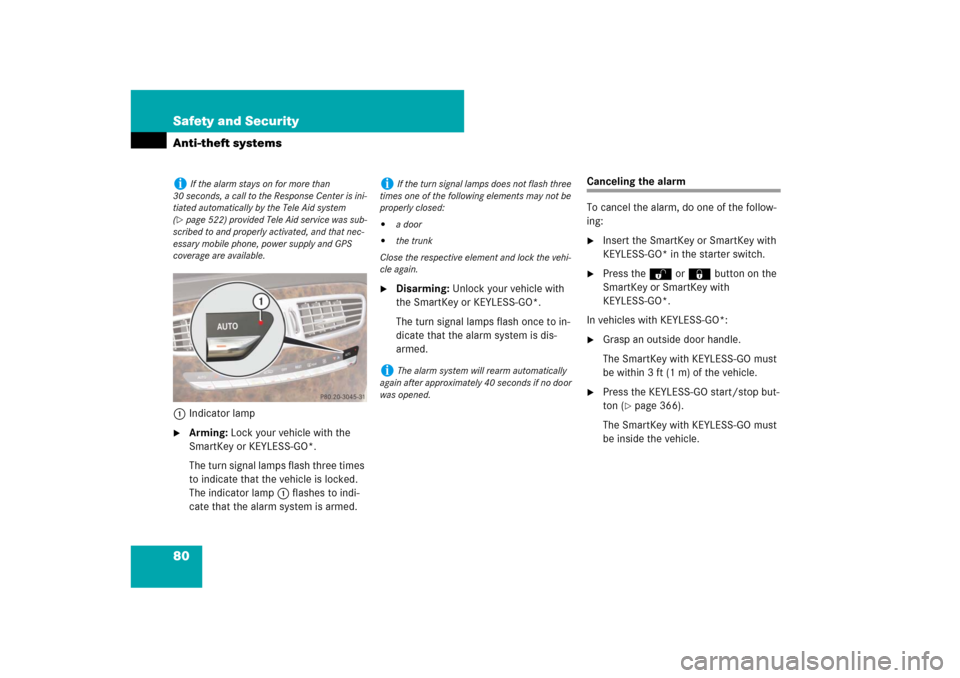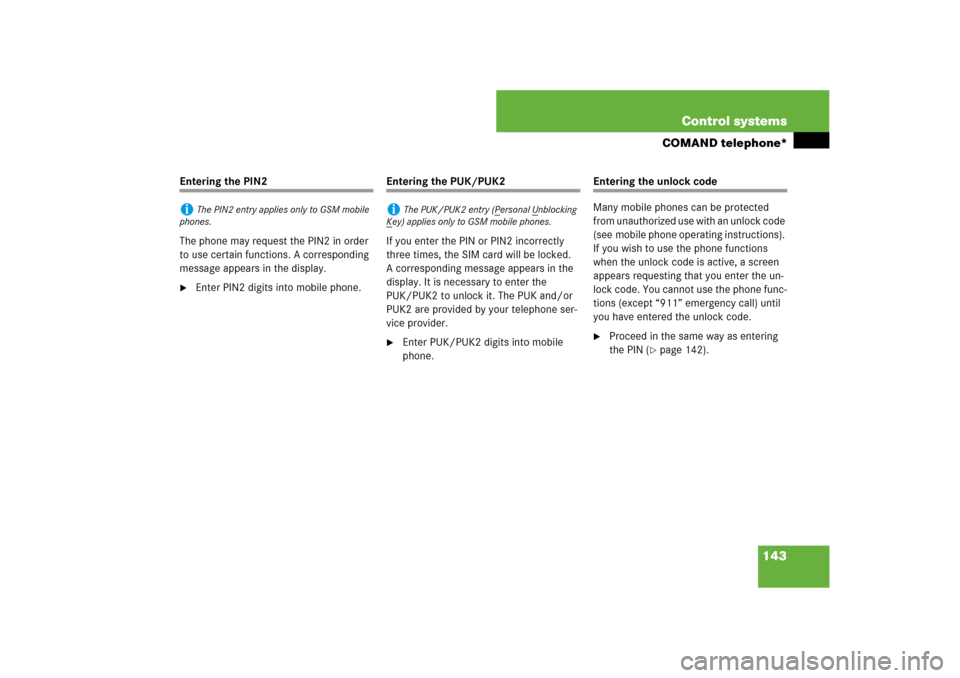Page 71 of 769

70 Safety and SecurityDriving safety systemsAfter a hard collision or damage to the
front of the vehicle from an accident, have
the adjustment and operation of the radar
sensors checked by an authorized
Mercedes-Benz Center.
If BAS Plus is not available due to a radar
sensor malfunction, the braking system
will continue to function normally with full
brake boost and full standard BAS
function.
EBP
The Electronic Brake Proportioning (EBP)
enhances braking effectiveness by allow-
ing the rear brakes to supply a greater pro-
portion of the braking effort in straight line
braking without a loss of vehicle stability.
ESP
®
The Electronic Stability Program (ESP
®) is
operational as soon as the engine is run-
ning and monitors the vehicle’s traction
(force of adhesive friction between the
tires and the road surface) and handling.
The ESP
® recognizes when a wheel is spin-
ning or if the vehicle starts to skid. By ap-
plying brakes to the appropriate wheel and
by limiting the engine output, the ESP
®
works to stabilize the vehicle. The ESP® is
especially useful while driving off and on
wet or slippery road surfaces. The ESP®
also stabilizes the vehicle during braking
and steering maneuvers.
The ESP
® warning lamp v in the instru-
ment cluster flashes when the ESP
® is en-
gaged.
The ESP
® warning lamp v in the instru-
ment cluster comes on when you switch on
the ignition (
�page 365). It goes out when
the engine is running.
Warning!
G
When the EBP is malfunctioning, the ABS,
BAS, BAS Plus* and ESP
® are also switched
off.
If the EBP is malfunctioning, the brake sys-
tem will still function with full brake boost.
However, the rear wheels could lock up dur-
ing emergency braking situations, for exam-
ple. You could lose control of the vehicle and
cause an accident. Adapt your driving style
to the changed driving characteristics.
Page 80 of 769

79 Safety and Security
Anti-theft systems
�Anti-theft systems
Immobilizer
The immobilizer prevents unauthorized
persons from starting your vehicle.
When leaving the vehicle, always take the
SmartKey or SmartKey with KEYLESS-GO*
with you, and lock the vehicle. The engine
can be started by anyone with a valid
SmartKey or SmartKey with KEYLESS-GO*
that is left inside the vehicle.
Activating�
With the SmartKey: Remove the
SmartKey from the starter switch.
�
With the KEYLESS-GO*: Turn off the
engine (
�page 366) and open the driv-
er’s door.
Deactivating
�
Switch on the ignition (
�page 365).
Anti-theft alarm system
Once the alarm system has been armed, a
visual and audible alarm is triggered when
someone opens:�
a door
�
the trunk
�
the hood
The alarm will stay on even if the activating
element (a door, for example) is immedi-
ately closed.
The alarm system will also be triggered
when
�
the vehicle is opened with the
mechanical key
�
a door is opened from the inside
To cancel the alarm after it has been trig-
gered, see “Canceling the alarm”
(
�page 80).
i
Starting the engine will also deactivate the
immobilizer.
In case the engine cannot be started (yet the ve-
hicle’s battery is charged), the system is not op-
erational. Contact an authorized Mercedes-Benz
Center or call 1-800-FOR-MERCedes (in the
USA), or 1-800-387-0100 (in Canada).
Page 81 of 769

80 Safety and SecurityAnti-theft systems1Indicator lamp�
Arming: Lock your vehicle with the
SmartKey or KEYLESS-GO*.
The turn signal lamps flash three times
to indicate that the vehicle is locked.
The indicator lamp1 flashes to indi-
cate that the alarm system is armed.
�
Disarming: Unlock your vehicle with
the SmartKey or KEYLESS-GO*.
The turn signal lamps flash once to in-
dicate that the alarm system is dis-
armed.
Canceling the alarm
To cancel the alarm, do one of the follow-
ing:�
Insert the SmartKey or SmartKey with
KEYLESS-GO* in the starter switch.
�
Press the Œ or ‹ button on the
SmartKey or SmartKey with
KEYLESS-GO*.
In vehicles with KEYLESS-GO*:
�
Grasp an outside door handle.
The SmartKey with KEYLESS-GO must
be within 3 ft (1 m) of the vehicle.
�
Press the KEYLESS-GO start/stop but-
ton (
�page 366).
The SmartKey with KEYLESS-GO must
be inside the vehicle.
i
If the alarm stays on for more than
30 seconds, a call to the Response Center is ini-
tiated automatically by the Tele Aid system
(
�page 522) provided Tele Aid service was sub-
scribed to and properly activated, and that nec-
essary mobile phone, power supply and GPS
coverage are available.
i
If the turn signal lamps does not flash three
times one of the following elements may not be
properly closed:
�
a door
�
the trunk
Close the respective element and lock the vehi-
cle again.
i
The alarm system will rearm automatically
again after approximately 40 seconds if no door
was opened.
Page 86 of 769
85 Control systems
COMAND introduction
Instrument cluster multifunction
display
This section describes features and con-
trols via the COMAND controller, display
and shortcut buttons only.
Please refer to the “Instrument cluster
control system” section of this manual
(�page 282) for function descriptions and
operation of the instrument cluster multi-
function display and multifunction steering
wheel buttons as they relate to COMAND
features described in this section.Adjusting COMAND display
illumination
1Knob
�
Brightening illumination: Turn
knob1 clockwise.
�
Dimming illumination: Turn knob1
counterclockwise.Swiveling COMAND display
1Button for swiveling display to the left
2Button for swiveling display to the right
You can swivel the COMAND display to the
left or right. The buttons are on the
right-hand side of the instrument cluster.
i
The layout of the menus may vary depending
on your vehicle’s equipment. This manual shows
the menus for a fully equipped vehicle.
Page 90 of 769
89 Control systems
COMAND introduction
Video DVD
Page
Vehicle
Page
Commands/menusVideo DVD
128
Exterior Lighting Delayed Switch-off
260
Submenu overview
130
Locator Lighting
261
Switching to video DVD mode
130
Exterior Mirror Convenience Settings
262
Pause playback
132
Automatic Locking
263
DVD menu
134
Easy Entry/Exit Feature
264
Video AUX
126
Interior Lighting Delayed Switch-off
266
Interior Ambient Light
265
Rear Window Sunshade
267
Trunk Opening-height Restriction*
268
Page 142 of 769

141 Control systems
COMAND telephone*
“911” emergency call
The following conditions must be fulfilled
in order to make a “911” emergency call:�
The phone is switched on.
�
A mobile network is available.
�
There is a valid SIM card in the phone
(not necessary in all mobile networks).
If you cannot make an emergency call, you
must initiate rescue measures yourself.
The “911” emergency call is a public ser-
vice. Any misuse is punishable by law.Placing a “911” emergency call before
entering PIN/PIN2, PUK/PUK2 or un-
lock code
Entering the number using the COMAND
controller
�
Select “Telephone” � “Dial 911”.
Entering the number using the tele-
phone keypad
�
Enter digits 9-1-1 (
�page 140).
�
Press s.Placing a “911” emergency call after
entering PIN/PIN2, PUK/PUK2 or un-
lock code
Entering the number using the COMAND
controller
�
Select “Telephone”.
�
Select all the digits in sequence.
�
Select “S”.
Entering the number using the tele-
phone keypad
�
Enter digits 9-1-1 (
�page 140).
�
Press s.
i
The “911” emergency call system is a public
service. Using it without due cause is a criminal
offense.
i
This function places a call to the local 911
provider. It does not initiate a Tele Aid call.
i
If no SIM card is inserted in the mobile
phone, you can only initiate a “911” emergency
call by using COMAND and the mobile phone.
Page 144 of 769

143 Control systems
COMAND telephone*
Entering the PIN2
The phone may request the PIN2 in order
to use certain functions. A corresponding
message appears in the display.�
Enter PIN2 digits into mobile phone.
Entering the PUK/PUK2
If you enter the PIN or PIN2 incorrectly
three times, the SIM card will be locked.
A corresponding message appears in the
display. It is necessary to enter the
PUK/PUK2 to unlock it. The PUK and/or
PUK2 are provided by your telephone ser-
vice provider.�
Enter PUK/PUK2 digits into mobile
phone.
Entering the unlock code
Many mobile phones can be protected
from unauthorized use with an unlock code
(see mobile phone operating instructions).
If you wish to use the phone functions
when the unlock code is active, a screen
appears requesting that you enter the un-
lock code. You cannot use the phone func-
tions (except “911” emergency call) until
you have entered the unlock code.�
Proceed in the same way as entering
the PIN (
�page 142).
i
The PIN2 entry applies only to GSM mobile
phones.
i
The PUK/PUK2 entry (P
ersonal U
nblocking
K
ey) applies only to GSM mobile phones.
Page 178 of 769

177 Control systems
COMAND telephone*
Calling up the Bluetooth
® device list
and searching for devices
�
Calling up the list: Select “Telephone”
� “Data/Connections” � “Bluetooth”
“Search for Bluetooth devices”.
When you call up the list for the first
time after switching on COMAND, the
search for devices in the reception
range starts automatically. You will see
a display to this effect.
The device list appears after a short
while.�
Canceling search:
Select “Cancel”.
The second time you call up the list, and
each time thereafter, the device list ap-
pears immediately if COMAND has not
been switched off and on again in the
meantime.
�
Starting search manually:
select “Update”.The device list can contain the following
devices:
�
All detected devices, whether autho-
rized or not.
�
All authorized devices, whether detect-
ed or not.
1Authorized and detected device – de-
vice and padlock symbol are the same
color
2Device which was not detected, but
which has been authorized in the past
– device and padlock symbol are differ-
ent colors (the device may be switched
off or not in the vehicle, for example)
3Newly detected device - not yet autho-
rized (no symbol)Displaying details of a Bluetooth
®
device
�
Call up the Bluetooth
® device list
(
�page 177).
�
Select desired device.
�
Select “Details”.
The detailed display for this device ap-
pears.
�
Closing detailed display: Slide qmr
or ymz.
i
If the device list already contains twelve au-
thorized devices, you must revoke authorization
for one of the authorized devices. Then you must
switch this device off and then restart the
search. Any new devices for which you would like
to search will otherwise not appear in the list.